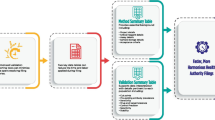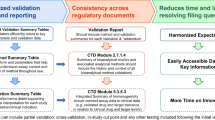Abstract
We designed a three-step statistical approach to transfer bioanalytical assays (ELISA and Biacore) which evaluates the (1) average equivalence between the two labs (2) concordance in individual sample results between the two labs, and (3) long-term stability of assay performance. Each experimental design evaluated the contribution of four critical variables to the overall variability. Two lots of each variable were examined in a controlled experiment. The variables tested for ELISA were analyst, plate washer, biotinylated-therapeutic protein, and streptavidin–horseradish peroxidase; and for Biacore were analyst, instrument, chip lot, and conjugation chemistry reagent lots. Equivalence in the mean signal to noise (S/N) or mean relative units (RU) between the two labs was established through statistical evaluation of the assay performance characteristics across multiple assay variables. Concordance between the two labs in the individual sample results was subsequently verified both quantitatively and qualitatively. The long-term maintenance of assay stability was monitored by performance testing of a predefined set of samples which were prepared in sufficient quantities to last several years. The process of method validation for biomarker testing in clinical trials is to analyze the variability of the assay performance. However, different factors contribute to this variability and need to be evaluated when the method is transferred to another site/lab. Lack of understanding the critical variables can potentially result in unexpected problems and delays. The three-step statistical approach of assay transfer provides a robust process for transferring complex biological assays.



Similar content being viewed by others
Abbreviations
- CCC:
-
coefficient of concordance correlation
- SAHRP:
-
streptavidin-conjugated horse radish peroxidase
- B-panitumumab:
-
biotin-conjugated panitumumab
- RU:
-
relative units
- S/N :
-
signal to noise ratio
References
Benson C. Guidance for Industry and FDA Staff: Recommendations for Clinical Laboratory Improvement Amendments of 1988 (CLIA) Waiver Applications for Manufacturers of In Vitro Diagnostic Devices. www.fda.gov; 2008.
Bland X, Altman X. Statistical methods for assessing agreement between two methods for clinical measurement. Lancet. 1986;8:307–10.
de Fontenay G. Analytical method transfer: new descriptive approach for acceptance criteria definition. J Pharm Biomed Anal. 2008;46:104–12.
FDA. Question to the Sponsor. http://www.fda.gov/CbER/products/pentacel/pentacel060707L.htm; 2007.
Lin L. Assay validation using the concordance correlation coefficient. Biometrics. 1992;48:599–604.
Lin L. A note on the concordance correlation coefficient. Biometrics. 2000;56:324–5.
Lofgren, Dhandhapani S, Pennucci JJ, Abbot CM, Mytych DT, Kaliyaperumal A, et al. Comparing ELISA and surface plasmon resonance for assessing clincial immunogenicity of panitumumab. J Immunol. 2007;178:7467–72.
Schuirmann D. A comparison of the two one-sided tests procedure and the power approach for assessing the equivalence of average bioavailability. J Pharmacokinet Biopharm. 1987;15:6570680.
Schwenke JR, O'Connor DK. Design and analysis of analytical method transfer studies. J Biopharm Stat. 2008;18:1013–33.
Zhong J, Lee K, Tsong Y. Statistical assessment of analytical method transfer. J Biopharm Stat. 2008;18:1005–12.
Acknowledgments
We thank the scientists at Amgen (Sarah Hoofring, Jim Lofgren, and Michelle Wu) for performing the assays; Marta Starcevic, Troy Barger, and Dan Mytych for helpful comments and experiences from previous assay transfer methods. This work was done at Amgen and all the authors hold company stock.
Author information
Authors and Affiliations
Corresponding author
Rights and permissions
About this article
Cite this article
Tatarewicz, S., Moxness, M., Weeraratne, D. et al. A Step-wise Approach for Transfer of Immunogenicity Assays during Clinical Drug Development. AAPS J 11, 526–534 (2009). https://doi.org/10.1208/s12248-009-9130-3
Received:
Accepted:
Published:
Issue Date:
DOI: https://doi.org/10.1208/s12248-009-9130-3




